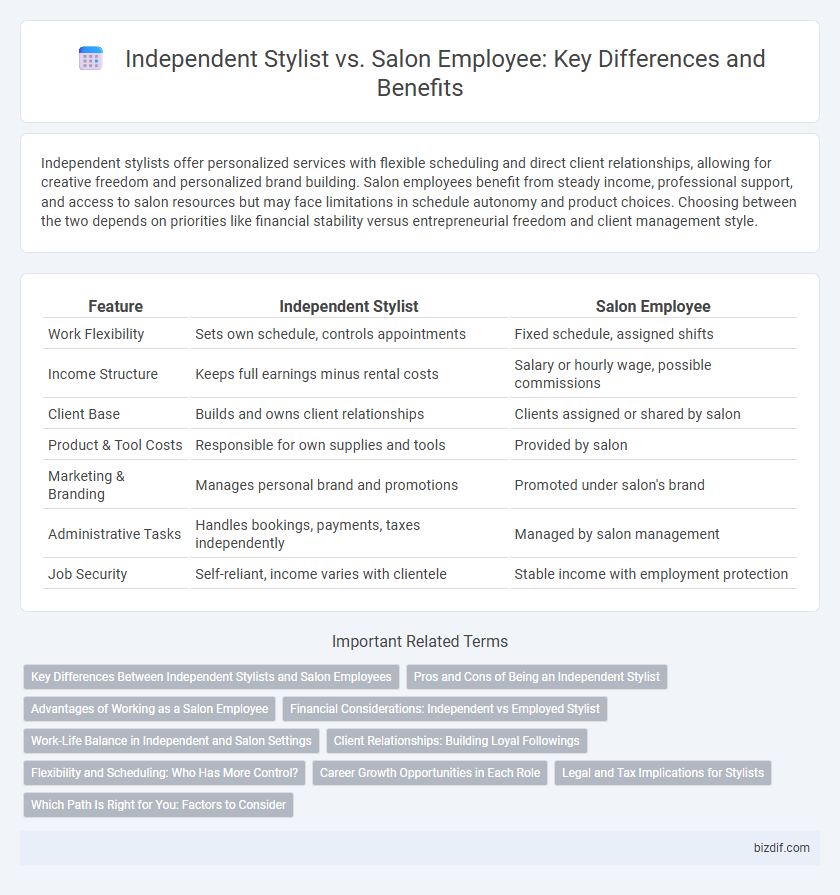Independent stylists offer personalized services with flexible scheduling and direct client relationships, allowing for creative freedom and personalized brand building. Salon employees benefit from steady income, professional support, and access to salon resources but may face limitations in schedule autonomy and product choices. Choosing between the two depends on priorities like financial stability versus entrepreneurial freedom and client management style.
Table of Comparison
| Feature | Independent Stylist | Salon Employee |
|---|---|---|
| Work Flexibility | Sets own schedule, controls appointments | Fixed schedule, assigned shifts |
| Income Structure | Keeps full earnings minus rental costs | Salary or hourly wage, possible commissions |
| Client Base | Builds and owns client relationships | Clients assigned or shared by salon |
| Product & Tool Costs | Responsible for own supplies and tools | Provided by salon |
| Marketing & Branding | Manages personal brand and promotions | Promoted under salon's brand |
| Administrative Tasks | Handles bookings, payments, taxes independently | Managed by salon management |
| Job Security | Self-reliant, income varies with clientele | Stable income with employment protection |
Key Differences Between Independent Stylists and Salon Employees
Independent stylists operate their own businesses, managing appointments, pricing, and marketing, which offers greater autonomy and flexibility compared to salon employees. Salon employees typically receive a steady paycheck and benefits while working under the salon's established brand and policies, limiting their control over client relationships and service pricing. Additionally, independent stylists invest in their own supplies and space, whereas salon employees utilize the salon's resources with less financial risk.
Pros and Cons of Being an Independent Stylist
Being an independent stylist offers the freedom to set personalized schedules, choose clients, and retain a larger portion of earnings, fostering entrepreneurial growth. However, this autonomy comes with challenges such as managing business expenses, securing consistent clientele, and handling administrative tasks without the support of a salon's infrastructure. Independent stylists often balance creative control and financial risk, unlike salon employees who benefit from stable paychecks and employer-provided resources.
Advantages of Working as a Salon Employee
Working as a salon employee provides job security, consistent income, and access to employee benefits such as health insurance and paid time off, which are often unavailable to independent stylists. Employees benefit from a steady client base, reduced administrative responsibilities, and supplied professional tools, allowing them to focus solely on hairstyling and client satisfaction. This stable work environment enhances skill development through mentorship and ongoing training opportunities offered by many salons.
Financial Considerations: Independent vs Employed Stylist
Independent stylists typically earn higher commissions, often retaining 70-100% of their service fees, but must cover their own expenses such as product supplies, rent, and insurance. Employed stylists receive a fixed hourly wage or salary with benefits, yet their earnings are generally lower per service, as salons deduct fees and manage overhead costs. Financially, independent stylists have greater income potential but face variable expenses and tax responsibilities, while employed stylists enjoy steady pay and reduced financial risk.
Work-Life Balance in Independent and Salon Settings
Independent stylists often experience greater work-life balance due to flexible scheduling and control over client appointments, allowing them to tailor their work hours around personal commitments. Salon employees typically adhere to fixed shifts and salon policies, which can limit flexibility but provide consistent income and benefits. Balancing autonomy and stability is a key consideration for stylists when choosing between independent and salon employment.
Client Relationships: Building Loyal Followings
Independent stylists foster stronger client relationships by offering personalized services tailored to individual needs, which cultivates trust and loyalty. Salon employees benefit from established brand recognition and a steady client base, but may face limitations in customizing experiences due to salon policies. Building a loyal following hinges on consistent communication, unique styling expertise, and the ability to create a welcoming atmosphere that encourages repeat visits.
Flexibility and Scheduling: Who Has More Control?
Independent stylists enjoy greater flexibility in scheduling, allowing them to set appointments according to their personal preferences and peak client demand times. Salon employees often adhere to fixed shifts and predetermined schedules set by salon management, limiting their control over work hours. This autonomy makes independent stylists better positioned to balance work-life commitments and optimize their earning potential.
Career Growth Opportunities in Each Role
Independent stylists experience accelerated career growth through building personal brands, client networks, and flexible service offerings, often leading to entrepreneurship or specialized expertise. Salon employees benefit from structured career paths, ongoing training, mentorship, and access to established client bases, which support steady professional development and skill enhancement. Each role presents distinct advancement opportunities shaped by autonomy, resource availability, and the scope for creative innovation.
Legal and Tax Implications for Stylists
Independent stylists operate as self-employed contractors, responsible for managing their own tax filings, including estimated quarterly tax payments and business expense deductions, while salon employees receive W-2 forms with taxes withheld by the salon. Legal implications for independent stylists include securing necessary licenses and insurances, setting their own schedules, and maintaining control over client relationships, whereas salon employees are subject to salon policies and typically benefit from employer-provided workers' compensation and unemployment protections. Understanding the differences in liability, tax obligations, and employment rights is crucial for stylists to choose the best working arrangement for their professional and financial goals.
Which Path Is Right for You: Factors to Consider
Choosing between an independent stylist and a salon employee depends on your priorities regarding flexibility, income potential, and client management. Independent stylists enjoy greater autonomy and control over their schedules and pricing but must handle marketing and business expenses independently. Salon employees benefit from a consistent client base, reduced administrative responsibilities, and often receive salaried pay with potential commission or bonuses.
Independent Stylist vs Salon Employee Infographic

 bizdif.com
bizdif.com